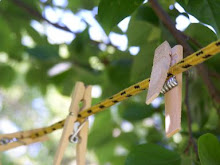(this is quite a long post, but I hope you'll stay with it and give some feedback from questions at the bottom!)
This is the title page article that has beckoned me for several days now, from the September 2009 issue of National Geographic. I guess I'm predisposed to gravitating toward such an article because I'm a history nut, especially this sort of anthropological history, which takes an educated stab at what Manhattan looked like 400 years ago. By using a map made by the British Army dating back to the Revolutionary War, and by taking one animal, the beaver, which happened upon the banks of the Bronx River in 2007 after years of restoration, one ecologist and a huge team of people were able to weave together an ecosystem where the beaver both depended on and was depended upon for food, shelter, water, trees, and many other animals, insects and elements. The artist - well, ecologist, -who spawned this idea of finding out what Manhattan looked like before too many people came, was able to come up with a virtual look at a wild Manhattan - a lovely forest with animals and trees that once had potential to be a park on par with Yellowstone.
What stood out to me the most about this article was this thing called the Muir web. "Consider a beaver that lived at Times Square in 1609. If you grabbed him by the scruff of his neck and lifted him out of the web, you'd find lines connecting him to a slowly meandering stream, to the aspen trees he ate, and to the mud and twigs he used to build a lodge. Not only that, you'd also find lines to the bobcats, bears and wolves that depended on him as prey and to the frogs, fish, and aquatic plants that lived in the pond he helped to create. 'The beaver, it turns out, is a landscape architect, just like people...You need him to flood the forest, which kills the trees that attract the woodpeckers that knock out cavities that wood ducks use for shelter.' Lifting a beaver out of the web disrupts cores of other residents which demonstrates how important it can be to think about an ecosystem as a network."
After reading this I began to think about what it would be like if someone in my "network" were lifted up out of this particular ecosystem. Individually, I thought, we may not have too much of a physical impact. For example, if I were lifted up out of this ecosystem, the environmental impact might not make too much difference - the air conditioner would still hum, the water would still run, gas and electricity in my house would still be used. I don't drive all that much, but that would be slightly lessened...you get my drift here. The husband, wife, father, mother of a household contributes different things to the survival of that unit, be it food, money, shelter, keeping the house clean, laundry clean, whatever. Ok. That said, we all know the bigger impact of an individual loss is the emotional one, even when the fallout affects other aspects of one's life. So it's interesting for me to think the same way about an actual ecosystem, like that of Mannahatta (Lenape people's name for Manhattan meaning "island of many hills" according to NG) 400 years ago, as individual species slowly died off in favor of infrastructure, people, "progress", growth, etc...a smaller picture of what is going on worldwide today. So what here is the emotional impact of our environmental destruction? A tree, for example, may continue to grow in the worst smog, drought, or poor-soil environment, but will that tree be as strong and healthy as a similar tree in a clean-air, soil-rich, healthy environment? Of course not - though they both may continue to grow at a similar rate. The effects of the environment on that first tree may be unseen, perhaps the seeds may be altered in some way though, and that will affect the way the next tree grows from that seed. This perhaps is the psychological equivalent to a child growing up in a family that doesn't function well or doesn't love the child.
In the way that invasive, non-native species often take over a piece of land, choking out native species and all the intricate, woven lives that surround them, we too, as a people are doing this at an alarming rate, causing so many different kinds of impacts we cannot possibly foresee. So what can we do? People, for now at least, are here to stay. A non-native species is invasive, as we are. My only thought is to come up with some life guidelines for treading lightly on this earth we call home in order to have the least impact with the homes that each of us live in.
Tread lightly.
Use the earth you have wisely.
Use the conveniences you have wisely.
Love your children as though they are the very seeds you plant for survival.
These are so general and I would love to hear what each of you have to say about this. Aside from the extremes like Low-Impact Man, what thoughts can you come up with that contribute to a general life set of guidelines for creating the least impact while still living where you are (meaning, I don't think too many people are willing to live in a Manhattan apartment without using electricity like Low-Impact Man)? And also, what are you doing that is "extreme" or out of the norm for where you live - or anywhere, for that matter?
-genny
by the way, if you want to see what NYC looked like from some random street 400 years ago, visit the Mannahatta Project here.



















